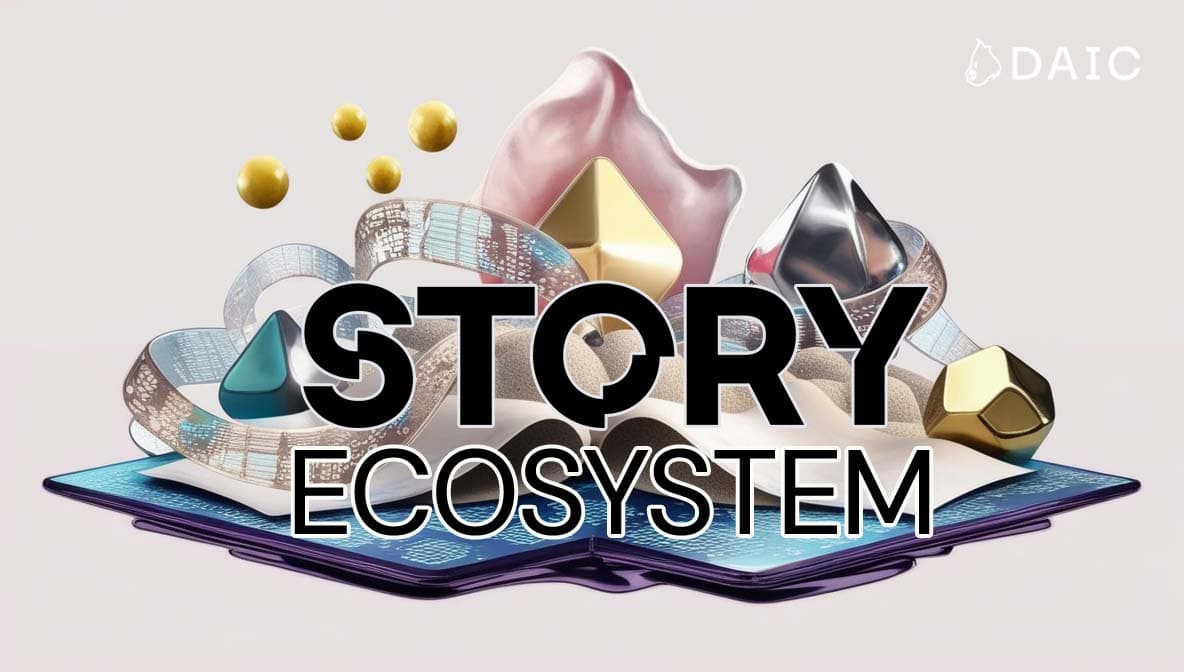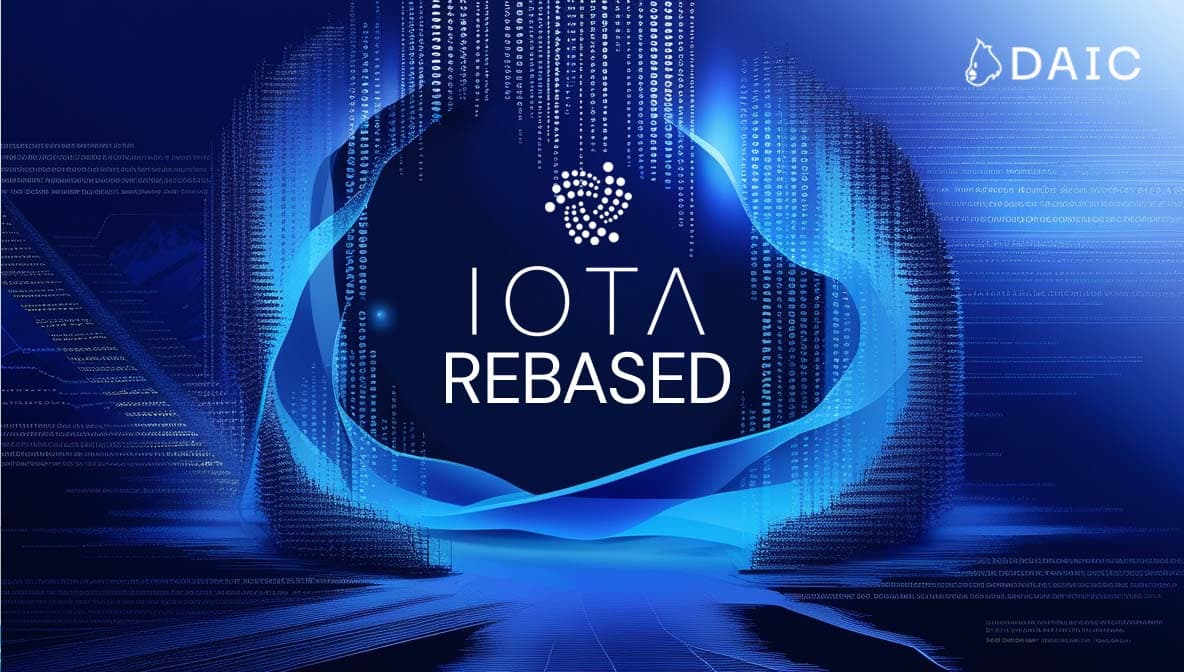The digital world is constantly transforming, yet often the ways we manage creative material haven't kept pace. Story blockchain was created to bridge that gap. It's a new field where your intellectual property (a song, a design, an algorithm, or a research paper) can be simply controlled, licensed, and even benefitted from, all with transparency and fairness. Story is about making it possible for better tools so that how we manage IP actually works well for our modern, high-speed digital age of creativity.
Key Takeaways
- Programmable IP: Story makes intellectual property (IP) into "IP Assets" with programmable rules for use, license, and revenue.
- Creator Focused: Provides creators with more control over IP, reducing reliance on complex intermediaries.
- User-Friendly Portal: The IP Portal makes it easy for non-developers to access Story Protocol, aiming to be the Hub for IP.
- AI & Web3 Ready: Built as a platform for the AI economy, tracking AI and enabling AI agent commerce.
- Decentralized Trust: Offers an open, immutable record for IP, encouraging transparency.
- EVM-Compatible: Compatible with Ethereum tools, seamless adoption of current apps.
Story: What It Is and What It’s For
So what is Story? At its foundation, Story is a Layer 1 blockchain that is designed to tackle the complexities of intellectual property (IP) in our digital lives. You can think of it as a global, open, and programmable hub for all types of creativity and knowledge. Not just another general-purpose blockchain, its actual architecture is optimized to handle IP as a primary element, a native asset class.
The platform empowers creators to register their IP directly on the blockchain, attach clear and customizable usage terms, and even automate things like royalty payments and licensing agreements.
Story is a sophisticated multi-core execution environment. That means it offers the convenience of EVM (Ethereum Virtual Machine) compatibility along with accessing special-purpose cores for particular types of operations like IP-specific, transparent cross-chain communication, and accepting real-world information through oracles.
This leads us to Story's core mission: rendering intellectual property accessible and fair for everyone. Let's be realistic, traditional IP systems can at times be sluggish, expensive, and a bit of a black box, which can be a significant hindrance for creators, especially if they are up-and-coming or independent. Story is going to change that by also making it easier to register IP, easier to find and license creative content, and lessening the need for middlemen. Essentially, it's about lowering the barriers, so more people are able to get the best out of their IP.
Looking at the bigger picture, Story’s vision is to lay the groundwork for a brand new "intelligence economy". The goal is for Story to become the universal go-to place, a repository and a programmable market, for all kinds of knowledge and creativity. It's a question of building an ecosystem in which ideas can be shared, expanded upon, and monetized more openly and fairly than ever before. Finally, Story wishes to be the foundational IP layer for the entirety of the internet, fully ready for the next excitement of Artificial Intelligence, and perhaps even creating a new age of innovation - a new Renaissance.
How Story Works: A Look Under the Hood
Story's system is a skillfully designed blend of innovative blockchain tech, smart legal systems, and innovative protocols, all working together to make management of IP easy and robust.
The Core Infrastructure: Network & Storage
The Story Network (Layer 1): This is the engine of Story, a purpose-built Layer 1 blockchain fully compatible with the Ethereum Virtual Machine (EVM), which means it readily works with many existing Ethereum tools and applications. It’s built using the Cosmos SDK and CometBFT consensus mechanism to ensure transactions are fast, cost-efficient, and finalize quickly. The network’s architecture is quite clever, featuring a main execution core alongside multiple specialized cores.
The Storage Layer: This layer is responsible for the effective management of all data, abstracting organizational complexity from on-chain as well as integrated off-chain solutions like IPFS and Arweave. Using smart data placement mechanisms similar to next-gen storage (like FTL), it optimizes performance, scalability, and cost for many IP assets from files to big machine learning models. This gives data integrity and enables capabilities like direct model inference, with the following protocol handling all complexity for deterministic behavior and network well-being.
Managing Your IP: Assets, Accounts, and Licenses
IP Assets & IP Accounts: Your intellectual property, once you upload it into Story, becomes an IP Asset. This is most typically symbolized by an ERC-721 Non-Fungible Token (NFT) that proves your ownership. Every IP Asset is then linked to its own IP Account, which is a specialized smart contract (a type of ERC-6551, also known as a Token Bound Account). The IP Account is the one and only identifier and control hub for your IP, storing all attached data (like metadata or any License Tokens generated from it) and making it accessible to engage with Story's various features and modules.
The Programmable IP License (PIL): A cornerstone of Story is the PIL. This is a standardized yet customizable legal framework, based on U.S. copyright law, that lets IP owners define clear terms for how their IP can be used, remixed, commercialized, and attributed. These terms are embedded with the IP Asset on the blockchain and are designed to be legally binding off-chain, creating a bridge between the digital and traditional legal worlds. Any licenses minted from an IP Asset are also ERC-721 NFTs, which means the specific rights to use an IP can be bought, sold, or traded.
Powering Interactions: Protocols & Modules
Proof of Creativity (PoC) Protocol: Think of this as Story’s operating system for IP. It's a vital set of smart contracts inherent within the Story Network that allows for registering, managing, and interacting with IP Assets and all their respective data and rights. The PoC protocol makes it easy to build that open library of IP, turning them into those malleable "IP legos.".
Modules: These are like plug-ins or apps for your IP Assets, implemented as customizable smart contracts that extend their functionality. Key modules include:
- Licensing Module: Manages license creation and defines the parent-child relationships between original IPs and their derivatives.
- Royalty Module: Automates how revenue flows between IPs, ensuring that earnings are distributed fairly along the derivative chain according to the agreed-upon terms. When an IP earns revenue, these payments (often made using whitelisted ERC-20 tokens called Revenue Tokens) go into the IP's dedicated Royalty Vault.
- Dispute Module: Provides a clear framework for anyone to raise and resolve IP-related disputes through arbitration. It allows for issues like improper registration, misuse of licensed IP, improper royalty payments, or content standards violations to be addressed. If an IP is found to be infringing, it can be "tagged," which can restrict its ability to generate licenses or earn revenue.
- Other Modules: Functionality is further extended by modules for Grouping IP Assets together and for managing their Metadata.
Connecting Story: Interoperability Features
Cross-Chain Communication: Story network ensures your IP isn't siloed, it's built to connect and interact across the broader blockchain world. A key to this is its support for advanced standards like the Inter-Blockchain Communication (IBC) protocol. This allows your registered IP assets to travel seamlessly, meaning your creations can be used in different marketplaces, find roles in DeFi applications (like serving as collateral), or connect with new services on other compatible chains. Importantly, your original ownership rules and monetization terms remain consistent and enforceable across these environments.
Off-Chain Synchronization (Oracles): To interact with the world beyond the blockchain, Story securely connects with real-world data and off-chain services. It helps bridge off-chain realities (like social identity verification, receiving off-chain payments, or generating legal contracts for off-chain use) with the on-chain world through a network of trusted off-chain entities providing attestations.
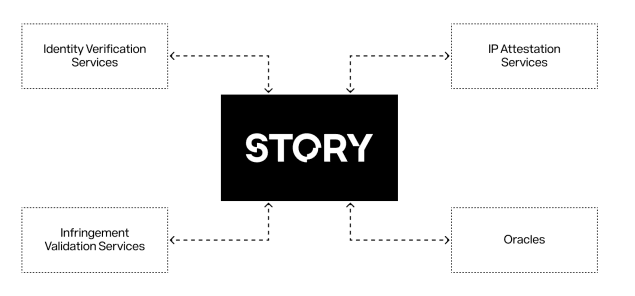
Ensuring Trust: IP Protection & Validation
IP Validation Service (IPVS): Story is building this as a decentralized "marketplace of trust" to support IP registration while offering robust protection. It combines sophisticated detection methods with strong dispute resolution mechanisms. The IPVS has two main components:
- Story Attestation Service (SAS): This service works with a network of specialized providers that use technology like AI and machine learning to detect potential copyright violations across different media on the internet and other blockchains. It provides transparent, publicly accessible signals about an IP Asset's legitimacy. For IPAs with commercial licenses, Story even submits the asset for an infringement check via a third-party attestation provider.
- Dispute Module (in IPVS): As mentioned earlier, this module provides the flexible framework for resolving conflicts, using both on-chain and adaptable off-chain processes to handle the often nuanced nature of IP disputes.
Attestations within the IPVS come from these specialized service providers as well as from applications that help register IP, creating a rich web of trust signals for the community.
Powering the AI Economy: Agent-to-Agent Transactions
Agent Transaction Control Protocol (Agent TCP/IP): Looking towards the future, especially with the rise of AI, Story is pioneering the Agent TCP/IP. This is a proposed standard designed to allow AI agents to interact and transact with each other autonomously when it comes to intellectual property. Imagine AI agents being able to negotiate terms, license IP assets (like datasets or algorithms) from each other or from human creators, and enforce these agreements using on-chain smart contracts that have off-chain legal backing - all powered by Story. This framework aims to create a future where AI agents can be independent economic actors, licensing data to improve themselves and monetizing their own creations by registering them as IP on Story. While still an evolving academic proposal with practical implementation guides being actively developed, Agent TCP/IP shows Story’s commitment to being a foundational layer for AI. Story even provides tools like a dedicated MCP (Model Context Protocol) server and examples of AI agents using it to interact with the protocol for tasks like minting and registering IP.
This detailed look shows how Story's different parts work together to create a comprehensive and forward-thinking platform for intellectual property.
Empowering Creators: The User-Friendly IP Portal
Navigating intellectual property (IP) can be complex, especially with AI changing the game. Story's IP Portal, now in open Beta, offers a clear solution. It's designed as the simplest way for anyone (creators, developers, or businesses) to register, license, and earn from their IP directly on the blockchain in just minutes. This kind of power, once mainly for large corporations, is now accessible to all.
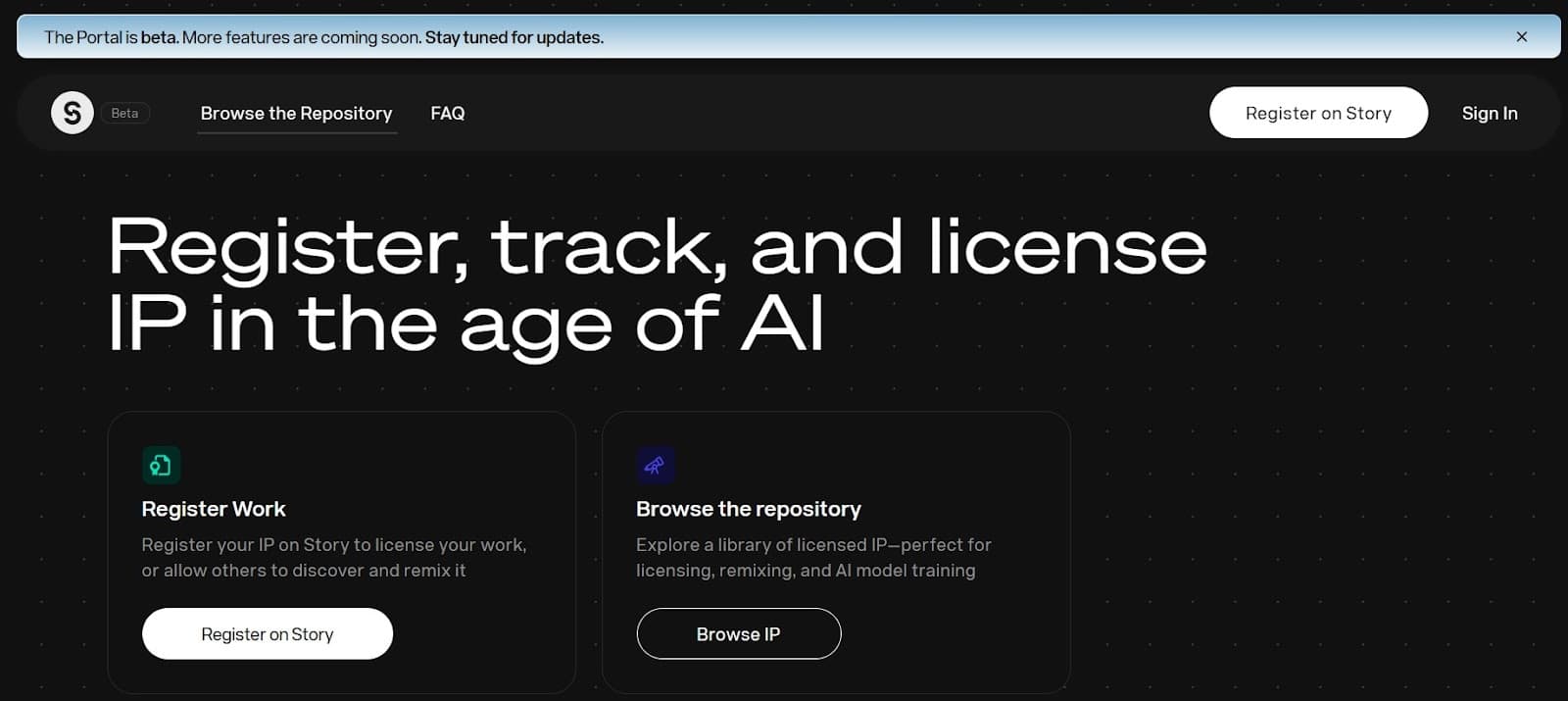
With the IP Portal, you can:
- Quickly Register Your IP: Secure on-chain ownership of your work (currently images, audio, and video up to 25MB) with a few clicks. Text and other file types are coming soon.
- Instantly Monetize via Licensing: Set up licenses for your IP using pre-configured, legally enforceable smart contracts. This means no need for lawyers or middlemen, allowing you to earn royalties automatically when your work is used.
- Opt-In for Fair AI Training: You can choose to make your IP available for AI model training and get compensated fairly, on your own terms.
- Soon: Remix and Collaborate: Features for Browse and remixing IP with automated attribution and revenue-sharing are on the way.
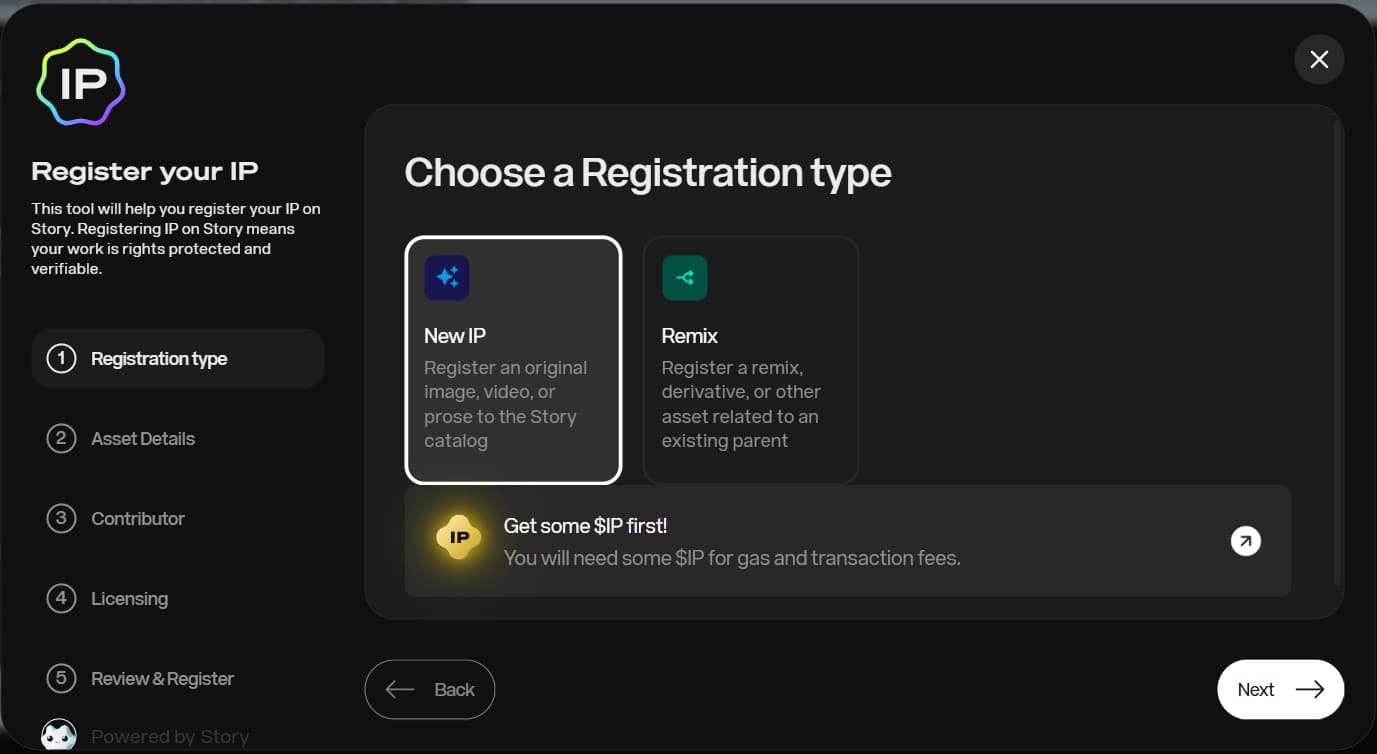
One of the sustaining philosophies behind the IP Portal is keeping creators at the forefront. Core functionalities like registering and licensing are free, with no take rates on the platform or gatekeepers to limit your revenue. You receive direct payments, own rights wholly, and your IP is held decentrally on the blockchain of Story.
Aside from these features, the IP Portal is your portal to Story's broader ecosystem. Once you've registered your IP, it could unlock other possibilities in areas like IPFi (IP Finance) and other innovative licensing structures developed by the community. It is about providing you with the ability to have your works readily owned, managed, and rewarded in today's fast-evolving digital landscape.
Tokenomics: Fueling the Story Ecosystem with IP
As intellectual property (IP) becomes an increasingly vital asset class, and Story is creating an open, programmable market for it. At the very heart of this new ecosystem is IP, the native token that fuels Story’s Layer 1 blockchain.
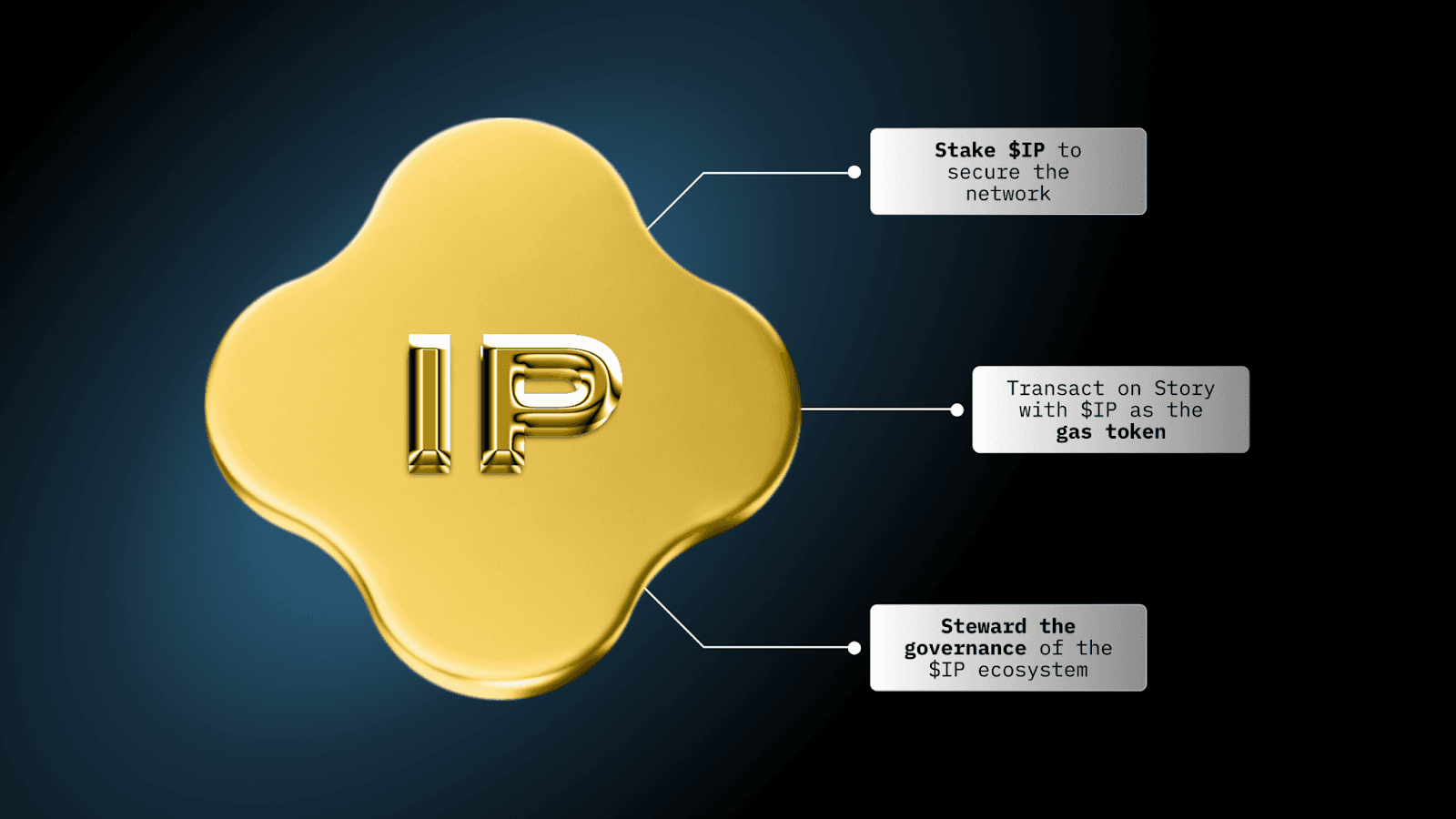
IP token isn't only a currency, it's a piece of network infrastructure and it plays some important functions:
Securing the Network (Staking): Validators, who help secure and keep the blockchain running through the validation of transactions, stake their IP tokens as a guarantee of network integrity. This also presents other $IP owners with a chance to delegate their tokens and participate in rewards.
Fueling Transactions (Gas Fees): IP token is used to pay for "gas" – the computing power required to carry out transactions and run smart contracts on the Story network.
Ecosystem Governance: Owners of the IP token have a voice in shaping the future of Story's onchain intellectual property marketplace through governance votes.
Facilitating Value Exchange: Aside from network transactions, IP is a utility token to facilitate various activities within the system. It's envisioned to facilitate value transfers of the form of IP-based payments such as licensing royalties, pay-per-use payments, and enabling the "Agent Economy" where AI agents can trade with IP. It's also key to the operation of the Proof of Creativity protocol.
$IP Token Distribution
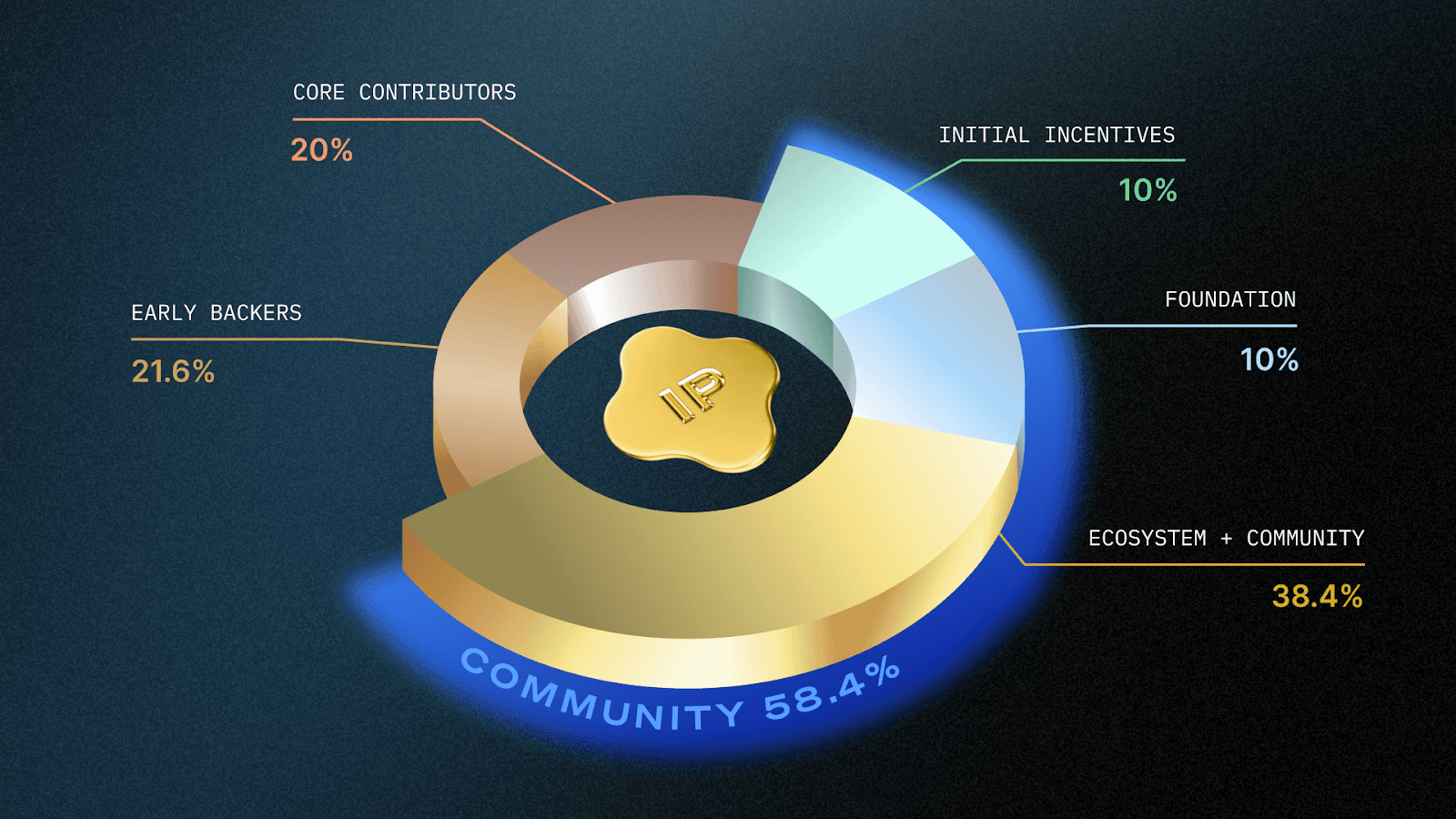
The overall distribution of IP at launch is 1 billion tokens. Among the core focuses of the distribution strategy is healthy growth and community involvement. To this end, over half of the tokens, and indeed 58.4%, are funneled into developing the ecosystem, expanding the community, supporting Foundation operations, and powering early incentive programs for fostering adoption and compensating early adopters. In further detail:
- 38.4% is dedicated to "Ecosystem + Community" initiatives like supporting developers, user and community groups in the form of grants, marketing, and other events.
- 10% is reserved for "Initial Incentives," disbursed through early rewards programs to incentivize early development.
- 10% goes to the "Foundation," which supports employees and services that contribute toward the long-term development of the Story blockchain, including key services and education.
Outside of these allocations, 21.6% are being set aside for "Early Backers," which are early investors and advisors who provided early support. Another 20% is allocated for "Core Contributors" as incentives for the team members responsible for building and developing the Story blockchain.
As for when these tokens are distributed, 25% of the supply was the initial unlocked supply of the launch. The Community tokens (distributed out of the Initial Incentives claim) started unlocking from the Public Mainnet's Day 1. Tokens for Early Backers and Core Contributors, on the other hand, are locked initially and then unlock in stages over a period of 48 months.
Other Key Tokens in the Ecosystem
Although IP is the primary network token, Story's ecosystem also uses a couple of other types of specialized tokens to manage IP rights and royalties effectively:
License Tokens: These are NFTs which symbolize the particular licensing rights someone has been assigned for an IP Asset.
Royalty Tokens: These tokens are an interest in the revenue being generated by a particular IP Asset. 100 Royalty Tokens are created for each IP Asset, and owning them implies you own a corresponding percentage of earnings on that IP.
Revenue Tokens: These are single whitelisted tokens used to make actual royalty payments. As an IP Asset earns revenue, these Revenue Tokens move into its corresponding Royalty Vault, and holders of the corresponding IP's Royalty Tokens can then take their share.
How to Stake Your IP Tokens: A Simple Guide
Staking your IP tokens is a great way to support the Story Protocol network, play a role in its governance, and earn rewards in the process. This simple guide, based on using the Story Protocol Staking Dashboard, will walk you through how to get started.
Before you dive into staking, here’s a quick checklist:
- Have Your IP Tokens: You'll need IP tokens to stake. You can explore cryptocurrency exchanges where it's listed by checking resources like CoinMarketCap.
- Set Up a Compatible Wallet: Make sure your IP tokens are in a compatible crypto wallet. Story network supports Cosmos-based wallets (like Keplr) as well as EVM-compatible wallets (such as MetaMask).
Understanding Staking Options & Key Mechanics
Story Protocol offers choices for how you stake your $IP, with a few important details:
Locked vs. Unlocked IP Staking: You can stake both "unlocked" IP (which are freely transferable) and "locked" $P (which are on an unlocking schedule). Staking locked IP earns rewards at half the rate (0.5x) of unlocked IP, but both types have the same voting power in governance. Validators choose to support either locked or unlocked token staking.
Staking Periods & Reward Boosts:
Flexible Staking is your go-to for an adaptable approach, allowing you to request unstaking anytime. This offers a standard reward multiplier (1.0x for unlocked IP, 0.5x for locked $IP).
If you're staking unlocked IP, you can opt for Fixed Periods (like 90, 360, or 540 days) to get higher reward multipliers—up to 2x for the longest period. Just remember, you can only unstake after your chosen fixed period ends.
The Unbonding Process: When you decide to unstake (from flexible staking or after a fixed period matures), your IP tokens enter a 14-day unbonding period. During these two weeks, you won’t earn rewards, and your tokens could still be slashed if your validator acts improperly.
Key Figures: Generally, you’ll need at least 1024 $IP to start staking or to unstake. Also, some actions like unstaking might have a small $IP fee, which is then burned.
Staking Your IP: Step-by-Step via the Dashboard
The Story Protocol Staking Dashboard provides a user-friendly way to stake your tokens.
1. Access the Dashboard & Connect Your Wallet:
- Navigate to the official Story Staking Dashboard.
- Click "Connect Wallet" and select your wallet type (e.g., MetaMask, Keplr) from the list.
- Approve the connection request in your wallet extension
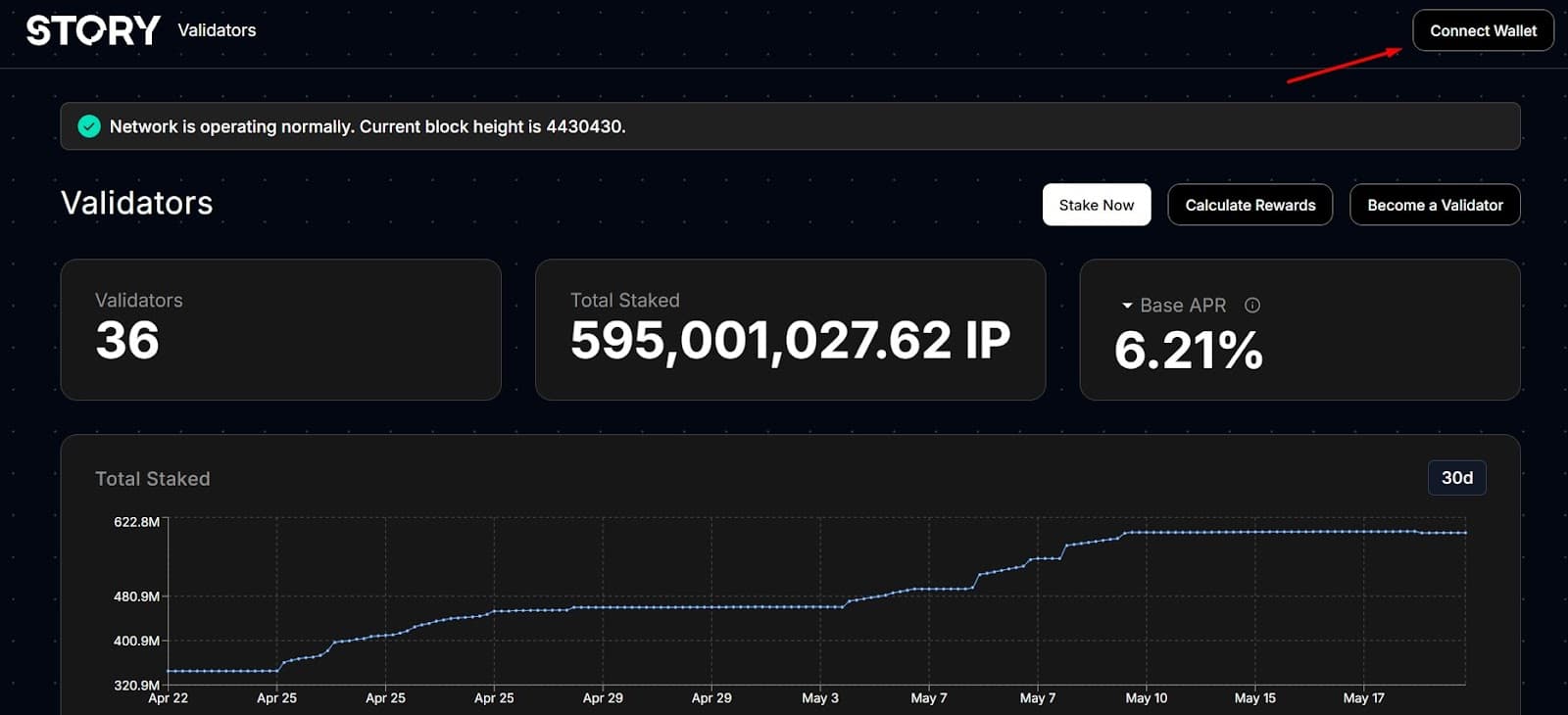
2. Choose a Validator:
- Browse the list of available validators. Remember, validators will specify if they support locked or unlocked token staking.
- On a validator's page, you can typically see their commission rates, your available $IP balance, and any currently staked amounts.

3. Stake Your Tokens:
- Click the "Stake" button for your chosen validator.
- In the pop-up enter the amount of IP you wish to stake (minimum 1024 IP) and select your preferred staking period (Flexible, 90 days, etc.) if staking unlocked tokens. Locked tokens will default to flexible staking.
- Click "Stake IP" and confirm the transaction in your wallet.
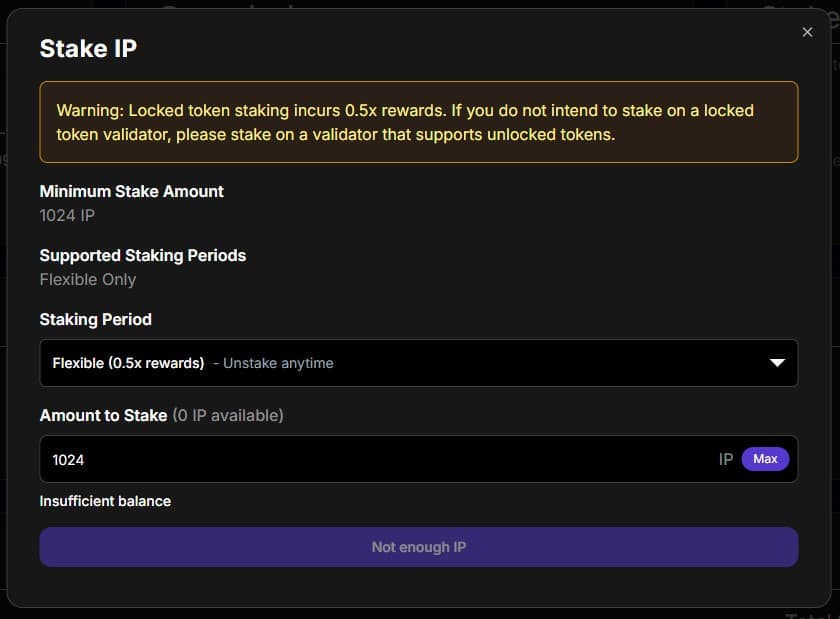
A confirmation message should appear on the dashboard upon successful staking.
Refresh the validator page to see your updated staked balance.
A few more things to keep in mind as a staker on Story:
- Switching Validators (Redelegation): You can move your staked IP to a different validator without fully unbonding, and you'll begin earning rewards with the new validator immediately. However, for 14 days, your redelegated tokens could still be affected if your original validator is slashed (if it was part of the active set). If you're on a fixed staking period, its terms, like the end date and reward rate, will carry over to the new validator.
- Understanding Slashing Risks: If your chosen validator misbehaves, for example, by having significant downtime or "double signing" (validating conflicting blocks) - they can be penalized. This penalty, called slashing, involves losing a portion of their staked IP, which would also affect the IP you've delegated to them.
- Customizing Payout Addresses: You have the flexibility to set a specific wallet address where your unstaked tokens will be sent (withdrawal address) and a potentially different one for where your staking rewards are distributed (reward address).
The Team Behind Story: Driving the Future of IP
Story Protocol is led by co-founders Seung Yoon “SY” Lee and Jason Zhao, who bring together distinct expertise and a shared passion for reshaping intellectual property.
Seung Yoon “SY” Lee (CEO & Co-founder) is a successful entrepreneur. Before Story, he was Global Strategy Officer at Kakao Entertainment, a role he took on after his hit mobile fiction app, Radish, was acquired by Kakao for $440M in 2021. This journey inspired SY to tackle even more fundamental challenges within the content and IP landscape through Story. An Oxford alumnus and a Forbes 30 Under 30 Asia honoree, SY has a strong background in media and scaling ventures.
Jason Zhao (Head of Protocol & Co-founder) brings a sharp perspective from the forefront of AI. Formerly the youngest Product Manager at DeepMind, he worked on turning cutting-edge AI research into practical applications. Jason saw that blockchain was essential for securing IP rights and fostering creativity in an age of abundant AI-generated content, a conviction that led him to co-found Story. He holds degrees in Philosophy and Computer Science from Stanford University.
SY and Jason connected at an accelerator and quickly found their visions for programmable IP aligned, with their skills - SY's entrepreneurial experience in media and Jason's deep technical and philosophical insights into AI and blockchain, being highly complementary. This dynamic partnership attracted significant backing. Since its inception around 2023, Story Protocol has completed three rounds of significant funding, raising $140 million, with Andreessen Horowitz (a16z) leading these rounds.
Future Vision and Story Evolution
Story is gradually developing ecosystem with clear vision of intellectual property's future. A solid foundation has been laid, but the team is continuously working on new functionality and features.
The IP Portal is set to evolve significantly from its current registration and Browse capabilities into a full-fledged monetization and collaboration platform for IP holders. Some of the core features that are in pipeline for the creators are:
- Tools for minting various licenses for their registered IP Assets.
- Functionality for earning and distributing royalties generated from the usage of their IP.
- Integrated dispute resolution features to handle conflicts related to IP assets.
- The ability to browse and remix IP created by others, with automated attribution and revenue-sharing mechanisms built-in.
The Story team promised that an expanded public Portal Roadmap will be published on the near horizon.
Broader Ecosystem and Network Enhancements
Beyond the IP Portal, the wider Story ecosystem and its underlying technology are also planned for further development:
The IP Validation Service (IPVS) is expected to evolve. Its current system of detection providers is planned to expand into a broader ecosystem of incentivized "signal contributors," each offering specialized, verifiable assessments of IP authenticity and legitimacy.
The Story Network itself can envision the addition of new specialized cores to further improve its capability. Discussion has been had about the possibility of an Artificial Intelligence (AI) Core to maximize AI-related on-chain computations, and a Zero-Knowledge (ZK) Core to optimize ZK-proof verification, which would greatly enhance privacy and scalability for IP trades.
Further technical details, for instance, regarding the advanced functionalities of the storage layer, are anticipated in follow-up technical papers.
Staying Updated
As Story Protocol continues to grow and roll out new features, the best way to stay informed about the detailed, time-lined public roadmap and the latest product announcements is to follow official Story channels, including their updates on X.
Conclusion
Story blockchain is on a mission to revolutionize our interface with intellectual property. With programmable, transparent, and composable IP, it presents a compelling alternative to existing systems, offering potential for creators to exert greater control, new possibilities for innovation and sources of revenue.
Its focus on integration with the world of AI and providing a future of "agentic commerce" with tools positions Story at the forefront of innovation in Web3. While the path to redefining a multi-trillion-dollar asset class is a hard one, Story's deep architecture, clear vision, and focus on utility provide a good foundation for establishing a fairer, more dynamic future for knowledge and imagination.
The information provided by DAIC, including but not limited to research, analysis, data, or other content, is offered solely for informational purposes and does not constitute investment advice, financial advice, trading advice, or any other type of advice. DAIC does not recommend the purchase, sale, or holding of any cryptocurrency or other investment.
